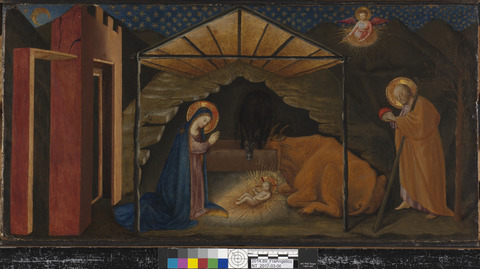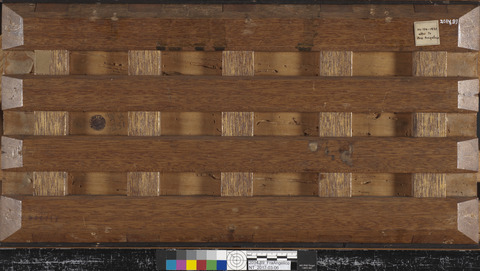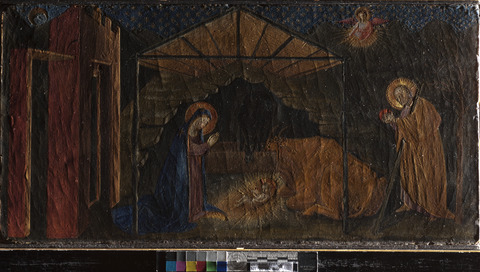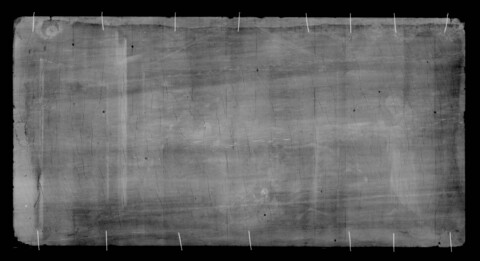Overview
Accession number: 2014.89
Artist: School of Fra Angelico
Title: Nativity
Materials: Egg tempera (untested) and gilding on poplar panel
Date of creation: About 1423–1426
Previous number/accession number: C10001
Dimensions:
23.8 × 48.3 cm (original panel)
24.9 × 48.3 cm (with edge strips)
Conservator/examiner: Roxane Sperber
Examination completed: 2021
Distinguishing Marks
Front:
None
Back:
Item 1. Marker inscription on paper label, upper-right corner on cradle, “No 104.1935/attr. to Fra Angelico” (tech. fig. 1)
Item 2. Inscription in white paint, upper-right corner on cradle, “2014.89” (tech. fig. 1)
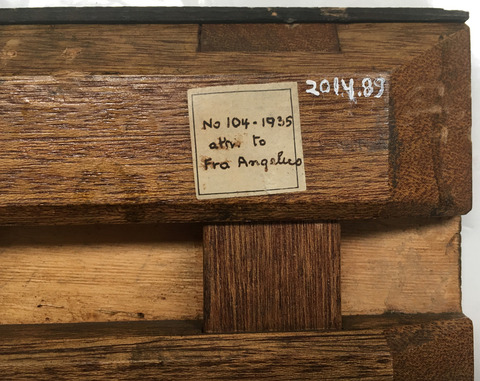
Item 3. Stamp, lower-left corner on cradle, “80717” (tech. fig. 2).
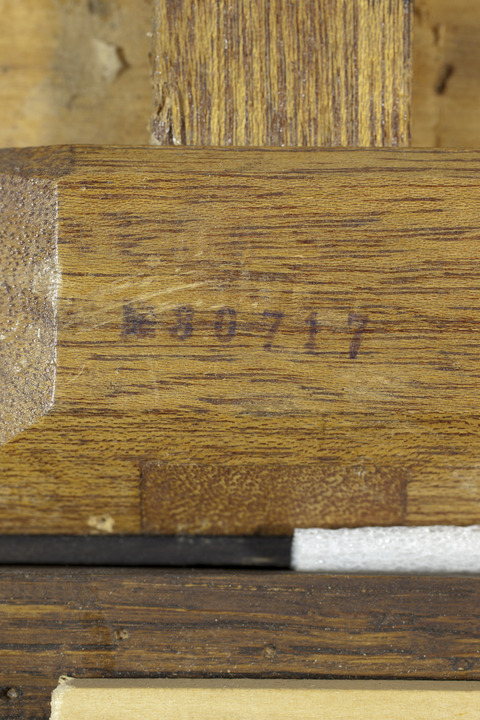
Item 4. Upside-down pencil inscription, center left on original panel between cradle members, “15.III/34 [illegible]” (tech. figs. 3, 4).

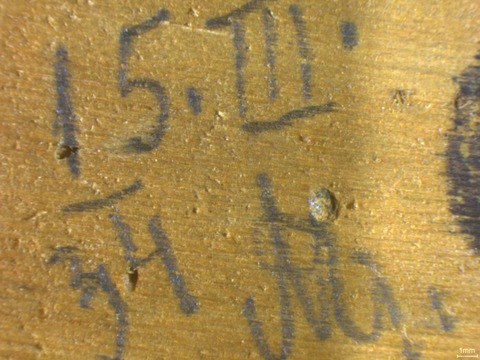
Item 5. Stamp, inscription, center left on original panel between cradle members, “illegible” (tech. figs. 3, 5).

Summary of Treatment History
The painting was once part of the predella of a larger altarpiece and has been significantly altered from its original construction. The predella was cut down at some stage into vignettes that were presumably sold as individual paintings. Physical evidence on the painting suggests that it has been treated numerous times prior to arrival at the IMA on long-term loan in 1971. The panel has been thinned, a cradle attached to the back, and edge strips were nailed to the top and bottom edges of the panel. Partial overpainting of the sky is present, as well as regilding on many of the stars. Extensive retouching is present across the rest of the panel.
Documentation suggests a series of condition assessments and treatments were carried out on the panel beginning with an examination at Harvard University’s Fogg Art Museum in 1934. This exam reported that the panel had been extensively abraded and repainted, particularly the area of the sky.1 In 1941, Dr. Clowes wrote to restorer Roman C. Diorio about an X-radiograph that had been taken of the painting and mentioned the work by the Fogg. Diorio’s assessment of the painting was that it was “extremely thin [and] completely restored."2
Several assessments of the collection were carried out around the time the works were moved from the Clowes residence to the IMA in 1971. A condition report by Paul Spheeris in October of that year, likely carried out before the paintings were relocated, described the painting as being in excellent condition with only a scratch in the roof of the manger. No treatment was recommended.3 A second condition assessment was carried out upon arrival of the paintings at the IMA and also found the work to be in excellent condition. An X-radiograph of the painting was made at this time.4
In 1974, a condition assessment, treatment, and investigation of the collection was carried out by the Intermuseum Conservation Association at Oberlin College. This document described this painting as having a heavy, discolored natural resin varnish and extensive overpaint that make it impossible to judge the “appropriateness of the original paint.” Removal of the surface coating and overpaint was recommended.5 However, the current condition of the work suggests this work was never carried out.6
The condition of the painting was documented in the Clowes Collection annual survey from 2011 to 2020.
Current Condition Summary
The painting is in aesthetically poor condition, but it is structurally stable. The paint layer has been severely abraded and large swatches of overpaint are present, particularly in the sky.
Methods of Examination, Imaging, and Analysis
| Examination/Imaging | Analysis (no sample required) | Analysis (sample required) |
|---|---|---|
| Unaided eye | Dendrochronology | Microchemical analysis |
| Optical microscopy | Wood identification | Fiber ID |
| Incident light | Microchemical analysis | Cross-section sampling |
| Raking light | Thread count analysis | Dispersed pigment sample |
| Reflected/specular light | X-ray fluorescence spectroscopy (XRF) | Fourier-transform infrared spectroscopy (FTIR) |
| Transmitted light | Macro X-ray fluorescence scanning (MA-XRF) | Raman microspectroscopy |
| Ultraviolet-induced visible fluorescence (UV) | ||
| Infrared reflectography (IRR) | Gas chromatography–mass spectrometry (GC-MS) | |
| Infrared transmittography (IRT) | Scanning electron microscope -energy dispersive X-ray spectroscopy (SEM-EDS) | |
| Infrared luminescence | Other: | |
| X-radiography |
Technical Examination
Description of Support
Analyzed Observed
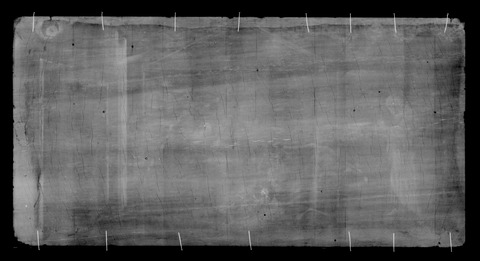
Material Type (fabric, wood, metal, dendrochronology results, fiber ID information, etc.):
The painting support has been identified as salicaceae, willow/poplar.7 The support is cut from a tangentially sawn piece of wood.
Characteristics of Construction/Fabrication (cusping, beveled edges of panels, seams or joins, battens):
The support is composed of a single horizontally oriented plank of wood that likely belonged to a larger predella that was later cut apart and sold as individual paintings.
Thickness (for panels or boards):
The original panel has been thinned and now measures 0.5 cm thick. The full panel and cradle are 2.5 cm thick.
Production/Dealer’s Marks:
None
Weave (structure, weight, thread thickness, etc):
There is a layer of plain-weave canvas that can be observed in the X-radiograph (tech. fig. 6). The frayed edges of the canvas, which do not extend to the edges of the panel, are visible on all sides. It is clear that the canvas was applied only to the painted surface and did not extend over the engaged frame. A similar application of canvas can be found on Fra Angelico’s Predella for the high altarpiece of San Domenico, Fiesole, although this is by no means an identifying characteristic of an artist’s studio.8
Auxiliary Support:
Original Not original Not able to discern None
A cradle comprising four horizontally oriented members that are fixed in place and five vertically oriented members that were designed to be movable has been applied to the thinned back of the panel. The horizontal members are beveled at the edges. The outer horizontal members are 4.5 cm wide. The inner horizontal members are 3.5 cm wide. The vertical members are 3.2 cm wide.
Edge strips have been added to the top and bottom of the panel. Small nails that are visible in the X-radiograph secure the edge strips in place. The addition of the edge strips has prevented the movement of the vertical cradle members.
Condition of Support
The support is in generally stable condition. There are no large losses or cracks. The panel was thinned before the application of the cradle. Evidence of considerable woodworm tunneling is visible on the back and was revealed when the panel was thinned.
Description of Ground
Analyzed Observed
Materials/Binding Medium:
XRF analysis confirmed the presence of a calcium sulfate (or gesso) ground (table 1, sample 1). This is typical of fourteenth-century Italian panel paintings and has been confirmed on other predellas firmly attributed to Fra Angelico.9
Color:
The ground is off-white in color (tech. fig. 7).
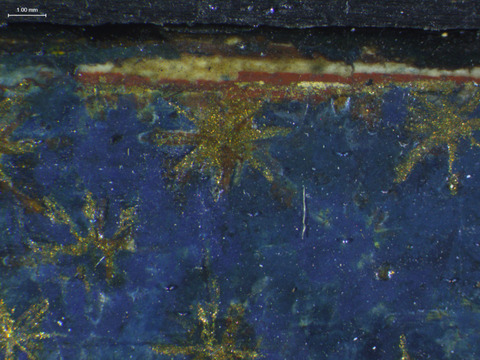
Application:
No cross section sample was taken from the painting, so it is unclear whether the ground was applied in a single layer or by applying a gesso grosso followed by a gesso sottile, as would be typical of Italian painting of this period.10 The ground appears to have been applied to both the surface of the painting and over an engaged frame, which was later removed, leaving a barb on the upper and lower edges of the panel (tech. fig. 7).
Thickness:
The ground is thickly applied and measures approximately 2 mm at the edge of the panel.
Sizing:
A thick size layer would have been applied to the panel before the canvas layer was adhered (see Description of Support). The canvas would then be “sopped” in size in order to adhere it to the panel.11
Character and Appearance (Does texture of support remain detectable/prominent?):
The ground is smooth and does not provide texture to the surface of the painting.
Condition of Ground
The ground is in generally good condition and is well adhered to the panel. There are small losses in the lower-left corner and along the edges of the panel.
Description of Composition Planning
Methods of Analysis:
Surface observation (unaided or with magnification)
Infrared reflectography (IRR)
X-radiography12
Analysis Parameters:
| X-radiography equipment | GE Inspection Technologies Type: ERESCO 200MFR 3.1, Tube S/N: MIR 201E 58-2812, EN 12543: 1.0mm, Filter: 0.8mm Be + 2mm Al |
|---|---|
| KV: | 26 |
| mA: | 3.0 |
| Exposure time (s) | 180 |
| Distance from x-ray tube: | 36” |
| IRR equipment and wavelength | Opus Instruments Osiris A1 infrared camera with InGaAs array detector operating at a wavelength of 0.9-1.7µm. |
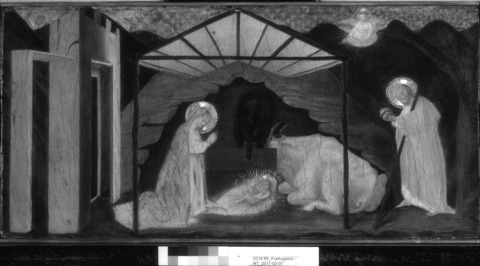
Medium/Technique:
Minimal underdrawing is visible when the painting is imaged with infrared reflectography (tech. fig. 8). Much of the paint used to create the buildings and background is highly absorbent in the IR region making it impossible to observe underdrawing in these areas. However, several lines of underdrawing are visible, one in the lower portion of Joseph’s cloak and another along the spine of the ox. These lines appear to be applied in a wet medium with a small brush. They are applied with a loose, gestural hand and appear to suggest outlines of the main components of the composition.
Incision lines are present along the top edge of the building and appear to have been used to guide the artist in creating perspective (tech. fig. 9). Incision lines are not visible in other areas of the architectural elements.
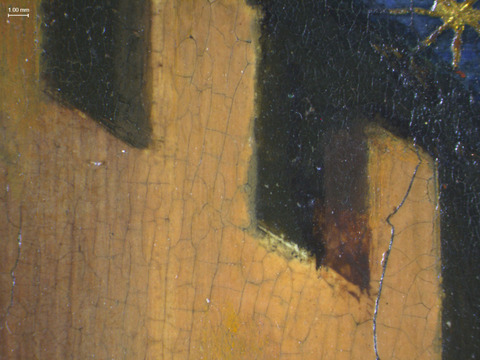
Description of Paint
Analyzed Observed
Application and Technique:
Water gilding:
Water gilding was applied in the sky and the halos of Mary, Joseph, and the Christ child. There is no evidence of incision lines delineating areas of gilding from the paint, either along the mountain or in the faces of the figures. In preparation for gilding, an iron-containing red bole was applied over the gesso (see tech. fig. 7). Gold leaf was then applied over the bole.
Paint layer:
The composition appears to have been carefully planned with each area of color being applied to its respective compositional element. The structure of the hut appears to have been established early in the painting process, and the foreground compositional elements, such as the body of the cow, have been carefully painted around the existing structure.
The stars in the sky appear to have been created using a sgraffito technique where the artist applied blue paint over an area of water gilding and then scratched the paint away to reveal the pattern of the stars. Linear indentations into the gold are visible on the stars that have not been regilded (tech. fig. 10), suggesting this technique was used rather than a technique where the stars were left in reserve.
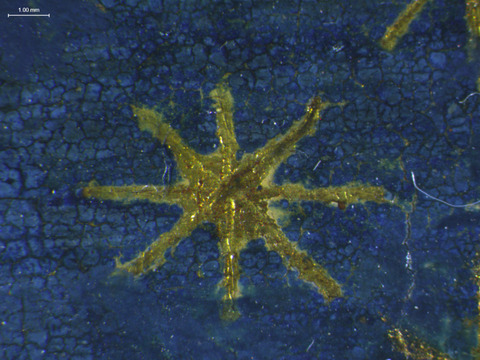
In the current condition, the painting technique appears quite clumsy. This is largely due to extensive abrasion, retouching, and overpaint. In areas where original paint is intact, it is clear the artist was quite accomplished. Even on a small scale, the faces are delicately rendered with detailed expressions.
Atypical of early Italian painting, no verdaccio layer appears to have been used in any of the faces (tech. fig. 11). Rather, an umber shadow was used to delineate the features, and strokes of pink and beige were layered over that to create form in the faces and hands (tech. fig. 12).
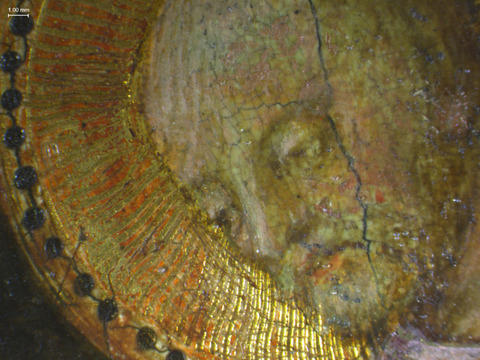
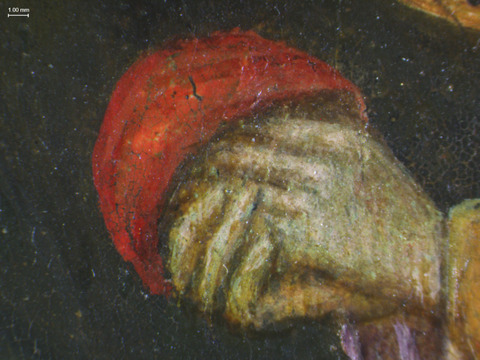
Punching:
The water gilding was burnished, and the halos were outlined with a simple dot punch. The halos were further elaborated with linear incisions emanating from the center of the halos (tech. fig. 13).
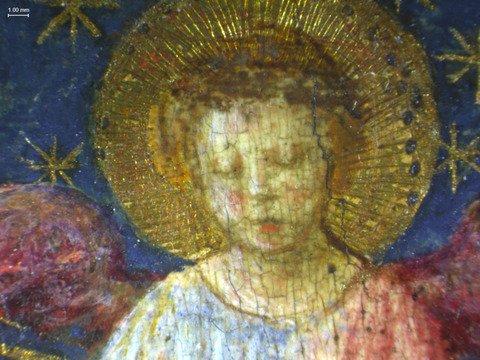
Mordant gilding:
Mordant gilding was applied to create the illusion of beams of light emanating from the Christ child and from the angel (tech. fig. 14). A mordant, probably oil (untested), was applied, and then shell gold would have been applied to the surface once the mordant was tacky.
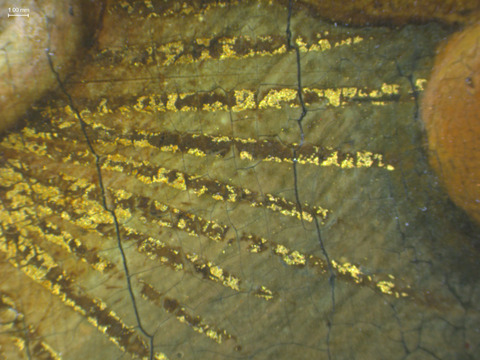
Painting Tools:
Small and medium-sized brushes were used for the details in the paint layer. Gilding materials such as brushing stones, punches, and incising tools were also used.
Binding Media:
Egg tempera (untested)
Color Palette:
XRF analysis combined with Raman microspectroscopy were used to identify the range of pigments used by the artist. Lead was found in all locations, suggesting the widespread use of lead white.
Mercury was detected in the red bowl held by Joseph (tech. fig. 15; table 1, sample 3) and in the Madonna’s face (tech. fig. 15; table 1, sample 12) suggesting the presence of vermilion in these passages. No vermilion was present in the angel’s robe, however, which was likely painted using a now-faded red lake pigment (this could not be confirmed using XRF).
Lead and tin were detected in Joseph’s yellow robe (tech. fig. 15; table 1, sample 2), suggesting lead-tin yellow was used to paint this passage. Iron was also detected in this location, suggesting iron oxide earth pigments such as yellow ocher may have been mixed with the lead-tin yellow. Iron was detected widely across the painting suggesting the widespread use of use of iron oxide earth pigments as well as an iron-containing bole layer in areas of gilding.
Copper was detected in numerous areas using XRF, suggesting the possible use of a copper-containing green and/or blue pigment. The detection of copper was not associated with a particular color passage, but rather appeared in a range of areas.
An area of original blue paint from the sky was analyzed using Raman microspectroscopy and was confirmed to be lapis lazuli (ultramarine). Overpaint from an adjacent area was also sampled and confirmed to contain French ultramarine. XRF analysis detected cobalt in another area of the overpainted sky suggesting a possible second campaign of retouching using cobalt blue (tech. fig. 15; table 1, sample 7).
Areas of original gilding contained pure gold (tech. fig. 15; table 1, sample 6). An area of regilding in the sky was analyzed and major peaks for zinc and copper were detected in addition to a minor peak for gold, suggesting the use of brass paint over the original gold leaf (tech. fig. 15; table 1, sample 8).
XRF Analysis:
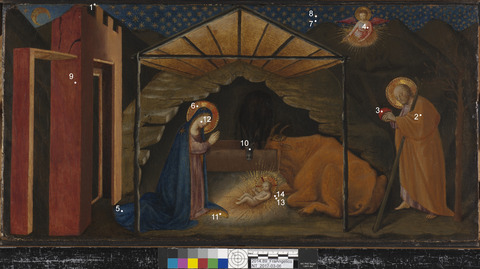
| Sample | Location | Elements | Possible Pigments |
|---|---|---|---|
| 1 | Ground, upper barb | Major: Ca, S Minor: Trace: Sr, K | Gesso ground (calcium sulfate). |
| 2 | Joseph’s robe highlight | Major: Fe, Pb Minor: Ca, Sr, Sn Trace: Si, Cu, Zn | Lead white, iron oxide (earth pigments), lead-tin yellow, calcium, and strontium (from gesso ground layer) |
| 3 | Red bowl in Joseph’s hands | Major: Hg, Pb, Ca Minor: Sr, Fe Trace: Si, K | Vermilion, lead white, iron oxide (earth pigments), calcium, and strontium (from gesso ground layer) |
| 4 | Angel’s robe shadow | Major: Ca, S Minor: Trace: Pb, Sr, K | Likely red lake pigments (not confirmed with XRF), trace of lead white, calcium, and strontium (from gesso ground layer). |
| 5 | Madonna’s blue robe | Major: Ca, Fe, Pb Minor: Pb, Cu, K Trace: Al, Si | Possible Prussian blue retouching (not confirmed with XRF), possible ultramarine blue (traces of Al, Si not confirmed with XRF), azurite, iron oxide (earth pigments), calcium, and strontium (from gesso ground layer). |
| 6 | Gold halo | Major: Fe, Au, Ca Minor: Sr Trace: Pb, Ti, K, Al, Si | Gold leaf, iron oxides/clay from bole, trace of lead white, calcium, and strontium (from gesso ground layer). |
| 7 | Blue sky repaint | Major: Pb, Co, Fe, Au Minor: Ca, Sr, Zn Trace: Pb, Ti, K, Al, Si | Cobalt blue, zinc white, gold leaf, iron oxides/clay from bole, trace of lead white, possible ultramarine blue (traces of Al, Si not confirmed with XRF), calcium, and strontium (from gesso ground layer). |
| 8 | Gold star repaint | Major: Cu, Zn, Pb Minor: Au, Fe, Ca, Co Trace: Sr, K | Brass paint, lead white, cobalt blue, iron oxide earth pigments (bole), calcium and strontium (from gesso ground layer). |
| 9 | Red building | Major: Ca, Pb Minor: Fe Trace: P, Cu, Zn | Lead white, iron oxide (earth pigments), possible red lake (not confirmed using XRF), bone black, calcium, and strontium (from gesso ground layer). |
| 10 | Donkey’s nose | Major: Ca, Pb Minor: Fe, Sr Trace: Cu, Zn, K | Carbon black, lead white, iron oxide (earth pigments), calcium, and strontium (from gesso ground layer). |
| 11 | Lining of Madonna’s robe | Major: Ca, Fe Minor: Sr Trace: K | Lead white, iron oxide (earth pigments), calcium, and strontium (from gesso ground layer). |
| 12 | Madonna’s skin tone | Major: Ca, Pb, Fe Minor: Sr Trace: Hg, Zn, K | Lead white, iron oxide (earth pigments), trace of vermillion, calcium, and strontium (from gesso ground layer). |
| 13 | Mordant | Major: Pb, Cu, Fe Minor: Ca, Sr Trace: K, Zn | Lead white, iron oxide (earth pigments), copper containing green and/or blue pigment, calcium, and strontium (from gesso ground layer). |
| 14 | Shell gold | Major: Au, Pb, Cu, Fe Minor: Ca, Sr Trace: K, Zn | Gold leaf, lead white, iron oxide (earth pigments), copper containing green and/or blue pigment, calcium, and strontium (from gesso ground layer). |
Table 1: Results of X-ray fluorescence analysis conducted with a Bruker Artax microfocus XRF with rhodium tube, silicon-drift detector, and polycapillary focusing lens (~100μm spot).
*Major, minor, trace quantities are based on XRF signal strength not quantitative analysis
Surface Appearance:
The paint layer is thinly and smoothly applied. The surface is aged with craquelure.
Condition of Paint
The paint layer and original gilding have been severely abraded, largely compromising the appreciation of the original artist’s work (tech. fig. 16). The panel has been largely repainted and regilded in areas that have been completely abraded. Although it is difficult to appreciate the quality due to abrasion, fragments of existing intact paint suggest the artistry was masterful as the work was originally conceived.
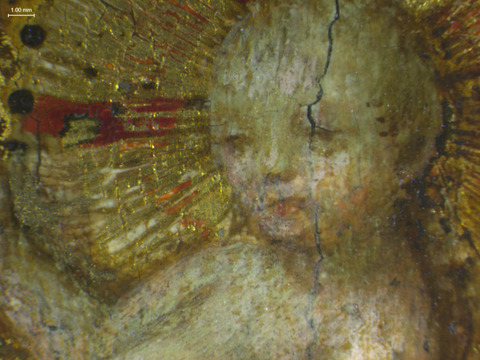
Overpaint is present in the sky, and significant regilding is present in the stars (tech. fig. 17).
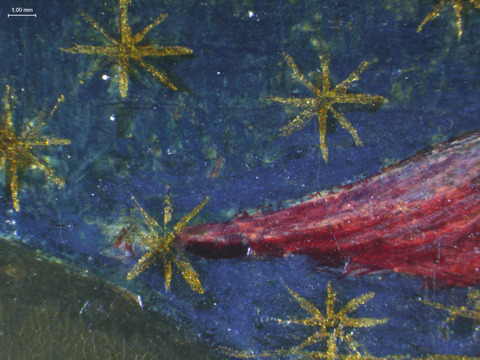
Description of Varnish/Surface Coating
Analyzed Observed Documented
| Type of Varnish | Application |
|---|---|
| Natural resin | Spray applied |
| Synthetic resin/other | Brush applied |
| Multiple Layers observed | Undetermined |
| No coating detected |
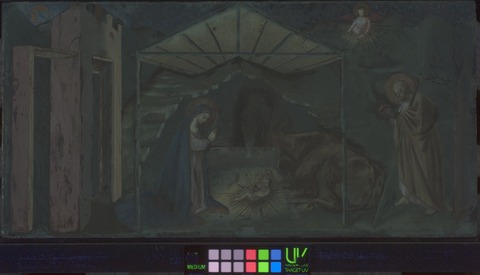
The painting has an overall coating that fluoresces greenish yellow under ultraviolet-induced visible fluorescence and is likely a natural resin coating (tech. fig. 18), although this has not been confirmed by analysis. Extensive retouching is visible as dark spots that block the fluorescence of the varnish layer. Further overpaint and campaigns of retouching can be observed using microscopy under the varnish layer.
Condition of Varnish/Surface Coating
The varnish is slightly yellowed, patchy, and desaturated, leaving the panel with an uneven surface appearance. This is especially obvious around the area of the donkey where retouching has become discolored and desaturated. Splatters of crizzled varnish are also present, further disrupting the appearance (tech. fig. 19).
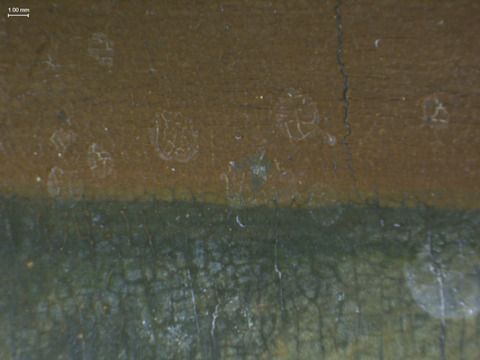
Description of Frame
Original/first frame
Period frame
Authenticity cannot be determined at this time/ further art historical research necessary
Reproduction frame (fabricated in the style of)
Replica frame (copy of an existing period frame)
Modern frame
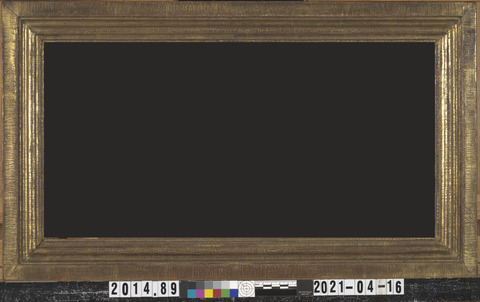
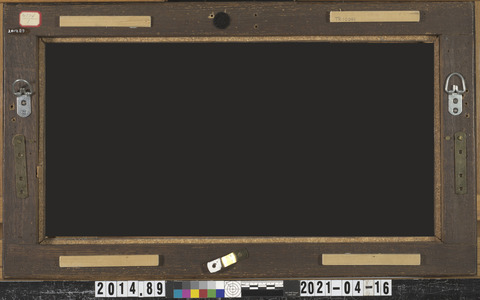
Frame Dimensions:
Outside frame dimensions: 37 × 57.5 × 3.5 cm
Sight size: 23.8 × 47.2 cm
Distinguishing Marks:
Item 6. Pencil inscription, upper frame member right side, “TR 10001” (tech. fig. 21).
Item 7. Painted inscription, white paint, upper-left corner, “2014.89” (tech. fig. 21).
Item 8. Paper label with red border and inscription, upper-left corner, “6734/1” (tech. fig. 21).
Description of Molding/Profile
The frame is a gilded cassetta frame with a simple molding (tech. fig. 22). The corners are mitered, and 0.5-cm-thick strips of wood have been applied to the back. The wood strips are butt joined at the corners as opposed to mirroring the mitered corners of the rest of the frame. There is a layer of canvas covering the front of the frame that is visible in a loss on the lower-right corner. This canvas is covered by a ground layer followed by a reddish-brown bole and water gilding.
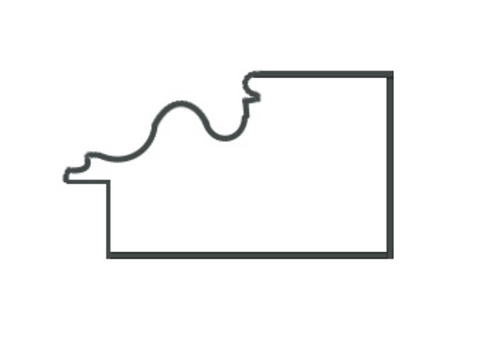
Condition of Frame
The frame is in good condition. There are very few losses to the gilding, although some abrasion is present. The frame is structurally stable.
Notes
-
Technical examination report from Harvard University’s Fogg Art Museum, 14 June 1934, File C10001, Clowes Registration Archive, Indianapolis Museum of Art at Newfields. ↩︎
-
Letter from Roman C. Diorio to G.H.A Clowes, 13 June 1941, Correspondence Files, Clowes Registration Archive, Indianapolis Museum of Art at Newfields. ↩︎
-
Paul A.J. Spheeris, “Conservation Report on the Condition of the Clowes Collection,” 25 October 1971, Conservation Department Files, Indianapolis Museum of Art at Newfields. ↩︎
-
Martin Radecki, Clowes Collection condition assessment, undated (after October 1971), Conservation Department Files, Indianapolis Museum of Art at Newfields. ↩︎
-
Intermuseum Conservation Association, “Clowes Collection Conservation Report,” C10001 (2014.89), 8–10 April 1974, Conservation Department Files, Indianapolis Museum of Art at Newfields. ↩︎
-
Memorandum from Carl J. Weinhardt to Martin J. Radecki, “Charges for Conservation of Objects in the Clowes Collection,” 15 February 1974, Conservation Department Files, Indianapolis Museum of Art at Newfields. ↩︎
-
Ian Tyers, “Tree-Ring Analysis and Wood Identification of Paintings from the Indianapolis Museum of Art: Dendrochronological Consultancy Report 1082,” January 2019, p. 33, Conservation Department Files, Indianapolis Museum of Art at Newfields. ↩︎
-
Dillian Gordon, Martin Wyld, and Ashok Roy, “Fra Angelico’s Predella for the High Altarpiece of San Domenico, Fiesole,” National Gallery Technical Bulletin 23, (2002): 12, fig 4, http://www.nationalgallery.org.uk/technical-bulletin/gordon_wyld_roy2002. ↩︎
-
Dillian Gordon, Martin Wyld, and Ashok Roy, “Fra Angelico’s Predella for the High Altarpiece of San Domenico, Fiesole,” National Gallery Technical Bulletin 23, (2002): 4–19, http://www.nationalgallery.org.uk/technical-bulletin/gordon_wyld_roy2002. ↩︎
-
Cennino Cennini, The Craftsman’s Handbook (Il libro dell’arte), trans. Daniel V. Thompson (New Haven: Yale University Press, 1936), 70–73. ↩︎
-
Cennino Cennini, The Craftsman’s Handbook (Il libro dell’arte), trans. Daniel V. Thompson (New Haven: Yale University Press, 1936), 70. ↩︎
-
Elvacite 2040 (synthetic resin) was used to fill the cradle so that its appearance would be minimized in the X-radiograph, allowing the composition to be better interpreted. ↩︎
Additional Images
